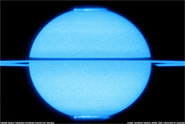4 August 2010
WASHINGTON—The ethereal ultraviolet glow, or aurora, that illuminates Saturn’s upper atmosphere near the planet’s poles is pulsing, recent observations show. What’s more, the glow waxes and wanes in conjunction with perplexing radio emissions that also emanate from the ringed planet.

Saturn’s ultraviolet auroras are visible over each pole in this 2009 image obtained using the Advanced Camera for Surveys on board the NASA/ESA Hubble Space Telescope. Credit: Jonathan Nichols, NASA, ESA, University of Leicester.
For years, scientists have puzzled over inexplicable variations in the timing of those radio pulsations. Now, the new-found aurora behaviour may offer a vital clue to what is going on.
“This is an important discovery because it provides a long-suspected, but hitherto missing, link between the radio and auroral emissions,” said Jonathan Nichols, a physics and astronomy researcher at the University of Leicester who led the study.
Saturn, like other magnetized planets, emits radio waves into space from the polar regions. These radio emissions pulse with a period near to 11 hours, and the timing of the pulses was originally thought to represent the rotation of the planet. However, over the years since the Voyager satellite missions, which flew past Saturn in 1980 and 1981, the period of the pulsing of the radio emissions has varied. Since the rotation of a planet cannot be easily sped up or slowed down, the hunt for the source of the varying radio period has become one of the most perplexing puzzles in planetary science.
Now, in a paper to be published in Geophysical Research Letters, a publication of the American Geophysical Union, the researchers use images from the NASA/ESA Hubble Space Telescope of Saturn’s auroras obtained between 2005–2009 to show that the auroras pulse in tandem with the radio emissions.
Auroras, known as the northern and southern lights on Earth, are caused when charged particles in space are funnelled along a planet’s magnetic field into the planet’s upper atmosphere near the poles, whereupon they impact the atmosphere, causing them to glow. This happens when a planet’s magnetic field is stressed by, for example, the buffeting from the stream of particles emitted by the Sun, or when moons such as Enceladus or Io expel material into the near-planet space.
Saturn’s radio waves were long suspected to be emitted by the charged particles as they hurtle toward the poles, but no radio-like pulsing had been observed in Saturn’s aurora. However, Nichols and his colleagues found that by using the timing of the radio pulses as a guide to organizing auroral data, and by stacking the results from all the Hubble Saturn auroral images from 2005–2009 on top of each other, the auroral pulses finally revealed themselves.
“This link is important since it implies that the pulsing of the radio emissions is being imparted by the processes driving Saturn’s aurora, which in turn can be studied by the NASA/ESA spacecraft Cassini, presently in orbit around Saturn,” Nichols said. “It thus takes us a significant step toward solving the mystery of the variable radio period.”
Joint Release
American Geophysical Union University of Leicester
AGU Contact:
Kathleen O’Neil, +1 (202) 777-7524, [email protected]
University of Leicester Contact:
Ather Mizra, 0116 252 3335, [email protected]
As of the date of this press release, the paper by Nichols et al is still “in press” (i.e. not yet published). Journalists and public information officers (PIOs) of educational and scientific institutions who have registered with AGU can download a PDF copy of this paper in press.
Or, you may order a copy of the paper by emailing your request to Kathleen O’Neil at [email protected]. Please provide your name, the name of your publication, and your phone number.
Neither the paper nor this press release are under embargo.
“Variation of Saturn's UV aurora with SKR phase”
J. D. Nichols, Department of Physics and Astronomy, University of Leicester, Leicester, UK.
Dr Jonathan Nichols, University of Leicester Radio and Space Plasma Physics Group, +44 (0)116 252 5049, [email protected]